 “In its characteristic form the type is a large, handsome weapon, with a simple flat tang, and a leaf-shaped blade of elaborate design. The form of the pommel… may fairly be called hat-shaped, being of a conical form, oval on plan, with strongly concave sides, finishing below in a broad brim-band, and above in a flattish, slightly bombe top. The surface may be left quite plain, or ornamented by incised lines in a combination of geometrical and ring-and-dot motifs. …the material of which they were normally made was perishable—wood, bone, or ivory… Pommels of the same form made of iron, sometimes elaborately inlaid with gold or ivory, occur on the long Hallstatt iron swords. Similar bronze pommels fitted to iron swords are known from Beilngries and from St. Flour with iron inlay. ”J.D. Cowen 1967 Introduction“Mindelheim” swords were the last and possibly the zenith of all bronze swords. It was also the first European sword to make the transition to iron. And though there are relatively few Mindelheim sword finds, their beautiful form speaks eloquently of the Early Iron Age history of Europe. Their ivory pommels tell of trade as far south as Africa and the amber inlay shows trade north to the Baltic. The longer more graceful blades with their odd blunted triangular points, point to a time when the first mounted swordsmen appeared in central Europe. In this article, I would like to explore these and other salient features of Mindelheim swords as well as the culture that produced them, especially in reference to burial customs and the explosion in trade that occurred in central Europe during the transition from bronze to iron. I will try to illustrate how the Mindelheim’s form and spectacular workmanship could reflect the opulence and power of a distinct ruling class of mounted warriors. The structural and design features of the Mindelheim can even give hints to the origin of this class of chieftains. SalzbergA short distance due east of the Mindelheim’s type location is the city of Salzberg Austria. “Salzberg” means “salt mountain” and it seems that some of the first owners of Mindelheim swords made their wealth by trading salt from the core of this mountain. They were not the first. Some of the earliest settlements in central Europe developed around salt mines in this area, some going back to Neolithic times. Salt is still mined there. Today salt is known as a rather cheap seasoning for our food. However, in the past, it was a very rich commodity—so valuable it was sometimes called “white gold.” Salt was the preservative; we might even say the “refrigeration,” of the ancient world.The most important finds of the Mindelheim type were found near Salzberg in one of the richest cemeteries ever discovered—a place called Hallstatt. The Hallstatt cemetery was discovered in the 19 th century in a clearing halfway up the mountain of salt. The director of the salt mine, Georg Ramsauer, found graves when digging gravel to use for mining roads. In the next 17 years, Ramsauer would excavate almost a thousand graves. Another thousand or so would come to light over the next century. Most of the graves from the Hallstatt cemetery date from the 6 th -7 th century. After that time, the grave count declines in number to the 4 th century when a giant rockfall destroyed the settlement. 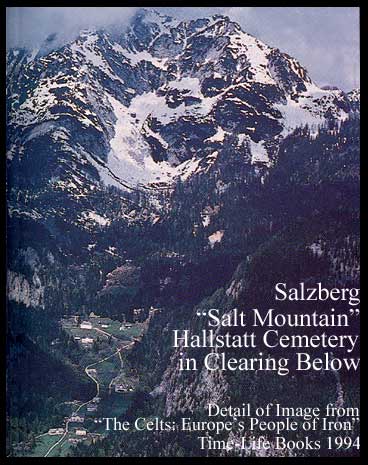 The Location of The Hallstatt Cemetery 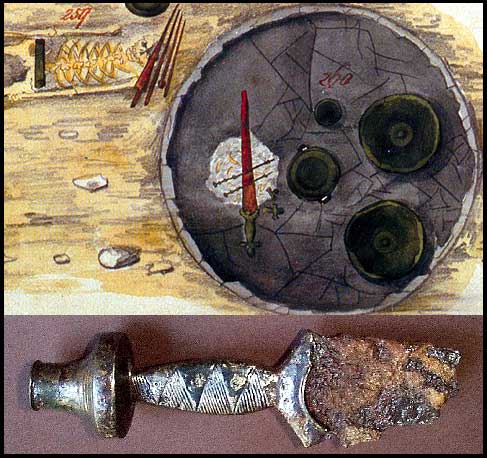 The painting at top is a small protion of a watercolor paintings Georg Ramsauer produced during his excavation showing grave 260. It is a cremation burial with grave goods placed on top of scattered ash. The photo at the bottom is the actual sword discovered in grave 260. It has a solid bronze hilt and a blade of iron. c. 650 B.C. Museum of Natural History Vienna, Austria. Photo source the TOMBA project.Hallstatt CultureThe quality and quantity of the Hallstatt cemetery finds, as well as their distinctive nature, established it as the type locality for a whole civilization. This Hallstatt culture, as it is called, began to come to light in the wake of the Celtomania craze of the early 19 th century. In this romantic mood, everything old was considered Celtic. As such, the Hallstatt and the earlier (and contemporary) Urnfield cultures were associated with the Celts. It is more common today to see the Urnfield and Hallstatt cultures as pre-Celtic or proto-Celtic. Be that as it may, this distinctive material culture of Hallstatt spread encompassed over seven centuries of time and spread from southern Germany westward through Europe to the British Isles and then southward into the Spain. As such, whether Celtic, proto-Celtic, pre-Celtic or non-Celtic, Hallstatt can stand on its own as an important area of study. Grave FindsAbout one quarter of the graves excavated in the Hallstatt cemetery contained various weapons and where thus designated as “warrior graves.” Yet archeologists have uncovered many other grave finds including a variety of bronze vessels including cups, bowls and buckets. They also found broaches, pins, pottery as well as an assortment of bronze and iron weapons. The grave finds of the Hallstatt period show a clear increase in the power and prestige of the ruling class, in both the size and opulence of the graves. The progression in these finds has allowed the Hallstatt period to be divided into four phases: A, B, C and D. The first two, Hallstatt A and B (HaA & HaB), are of the late Bronze Age and correspond to the latter phases of the Urnfield culture further to the north and west. (The Urnfield Culture, as the name might imply, is typified by cremation burials in urns, buried below ground in flat “fields” as there are no mounds at the surface to mark the grave location.) The earliest Hallstatt period (HaA) shares many characteristics of the Urnfields including cremation burial. Later Hallstatt burials are all inhumations (burials of the body intact). In the graves of Hallstatt C (HaC), we find the earliest Iron Age remains in Europe and clear evidence of imported material such as ivory, amber and glass. At the end of HaC and throughout HaD archeologists have uncovered what are called Chariot (Wagon or Cart) burials. It seems that the Chariot had become such a status symbol that members of the ruling class were often buried with their fancy “cars.” Actually such a practice can be found earlier to the east, suggesting some form of diffusion or migration of culture from that direction. By HaD the sidearm of Hallstatt warriors had diminished form long sword to only elaborate daggers. And though blades were shorter, the graves of this warrior class were larger. Some were impressive mounds full of Greek and Etruscan imports. These mound burials or tumuli were often associated with hilltop fortresses. While it is still unclear what role these hilltop fortresses may have played, it is clear that they mark a time of westward expansion in the Hallstatt culture and show that individuals and/or groups had the capacity to mobilize labor on a massive scale. In the 1970s, one of these HaD tombs was found intact. This fantastic discovery would show just how fine these warrior burials could be. In the elaborate wooden chamber lined with textiles and flowers, archeologists found a beautifully furnished funerary wagon. They found fine fabrics, wool cloth and badger skin covering an embossed bronze and iron bier in the shape of a couch on wheels. There were also toiletry items, such as razor and nail scissors. Among the chieftain’s possessions, they found gold embroidered shoes, fine daggers, three fishhooks and a quiver with arrows—though no bow was found. The tomb contained various bronze vessels including a dinner set with accessories, as well as a large drinking service with nine drinking horns to be used during banquets to serve from a large bronze cauldron decorated with lions. It held 104 gallons of some form of drink, maybe mead, the honeyed drink of the noble class. HaC and HaD were times of tremendous influence and connections south from the Baltic to the Mediterranean and from Eastern Europe to Britain. However, for some reason, in the 5 th century, these impressive hilltop fortresses fell into ruin and the Hallstatt period came to an end. Soon the La Tene culture, also with fine chariot burials, filled the cultural vacuum. Distinctive Swords of the Hallstatt CultureThe swords of the HaA and HaB are almost identical to the Grip Tongue swords that preceded them. However, in HaC (800-600 B.C.), Hallstatt swords began to develop their own distinctive form: Blade: The typical narrow leaf-shaped blade grows more heavy and longer, with a broad neck. The greatest width of the leaf-blade is unusually lower, below center towards the point. The grooves on older forms are replaced with decorative ridges or ribs, which follow and outline the outer edges of the blade and eventually fade into a ledge near the point. (The Mindelheim type also has elaborate rounded rib in the center of the blade). The ricasso is always short, with a notch greatly varying in depth. The point is clipped or terminated in a characteristic blunt triangular formation, in that the sides are drawn in at an angle of 45 degrees to the axis of the blade; and is, accordingly, wholly inappropriate for employment in thrusting (Cowen, 1967). 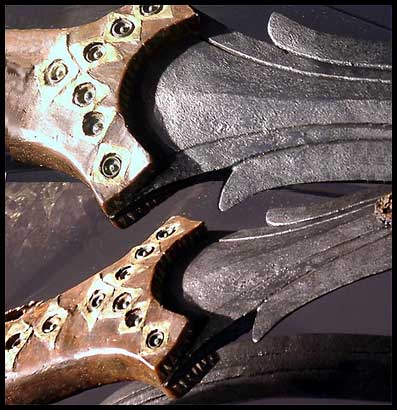 The “Kind Oss” iron Mindelheim Sword from Noord-Brabant Netherlands. Total length 83 cm. Notice the pointed shoulders, short deep ricasso, decorative ribs and thick neck. Photo source Jeroen Zuiderwijk. Same as above also showing blunted triangular point. Photo source Anton deVries Tang: The tang always swells, sometimes quite sharply, to a point of greatest width somewhat below its center. The tang is generally flat; that is without flanges (raised projections along the edges to hold grip plates in place). But a flanged effect is often produced by a slight dishing along the edges. The shoulders are often sharply pointed. And J.D. Cowen states that the upper edges of the shoulders “usually form a more nearly horizontal line than in any other variety of flange hilted sword.” This shorter more horizontal, or cruciform, character is also more common in cultures to the east. The most usual number of rivets is two, though one is not uncommon; three also occur, but more are exceptional. Rivets tend to be grouped within the wider (that is the lower) end of the tang, leaving a blank space at the top of the tang below the pommel-piece. 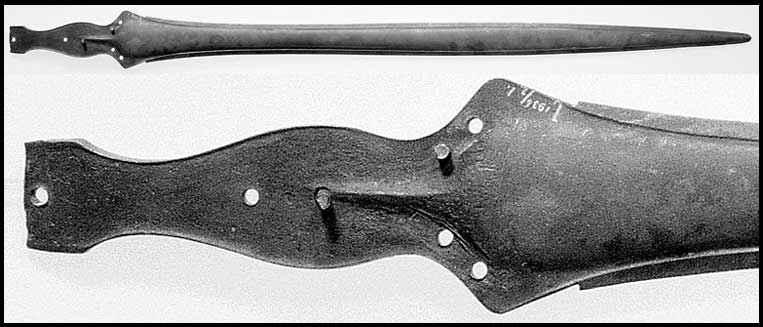 Close-up of Tang of Gundlingen Sword. Photo source Archeologische vondsten uit Nederland. Pommel Piece: One of the most obvious and defining characteristics of Hallstatt C (HaC) swords is something called the “pommel-piece.” It is an extension of the end of the tang to fit inside the pommel. There were extensions of the tang before the Hallstatt period and especially during the beginning of the Hallstatt culture (HaA), which archeologist called “the pommel tang.” This tab was a device for steadying the pommel. However it provided no specific means for attaching the pommel directly to the pommel tang itself. 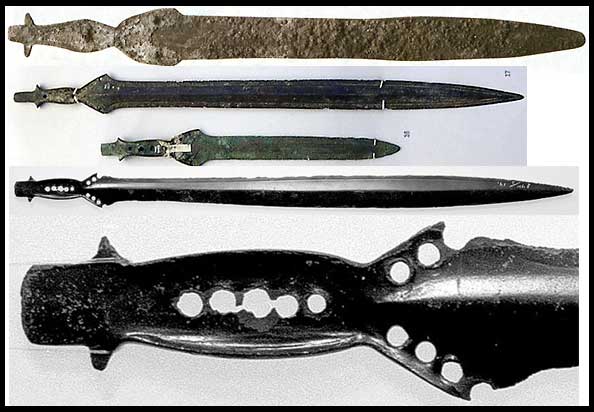 Pommel Tangs. Before Hallstatt C there were extensions of the tang called pommel tangs. They were inserted into the pommel but there was no means of attachment to the tang as we find with the “pommel-piece” of HaC. The tongue like projection on the swords shown is the pommel tang. The top sword in the group is a Philistine sword from Ramallah Israel. c. 1100 B.C. The others are Late Bronze Age European swords. Lower photo source Archeologische vondsten uit Nederland. Hallstatt C swords were the first with clear design changes to fix the pommel directly to the tang. To this end the pommel-piece may have rivet-holes, peg holes, peg-clefts or hooked ears and, in Mindelheim, spike-tangs to attach and hold the pommel securely to the tang. Different Types of Pommel Pieces. Photo source Cowen, 1967. Attachment devices are always present in the pommel-piece, singly or in conjunction. These different strategies of securely attaching the pommel to the tang show no chronological development in technology, but rather, seem to be distributed geographically (Cowen, 1967). In other words, each region had its own particular variation as it attempted to secure the pommel to the hilt rather than demonstrating a steady progression toward the “best” mode of attachment. PommelThe pommel on swords preceding the HaC period west generally had a mushroomed, flattened ovoid or less commonly an antenna shaped pommel. With Hallstatt swords, we begin to see a new shape. It takes what has been called a “Mexican Hat” shape. Although most of these pommels were made of wood and have long since decayed, many of the Hallstatt pommels were made of more costly ivory and bronze and thus survive to show the beautiful form and decoration that existed. Mindelheim Pommels in Bronze. Photo source Schauer 1971 & Cowen 1967 (drawings) the TOMBA project (photos).] 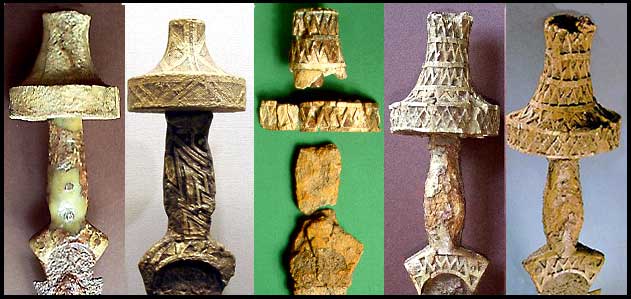 Mindelheim Pommels in Ivory many with cut-out for amber or, more rarely, red coral inlay. Photo source Jeroen Zuiderwijk & the TOMBA project. There are a limited number of flange-hilted swords with a separately cast antennae-shaped pommels often dated to HaB. In at least one case this antennae style pommel has made the transition to a Gundlingen HaC sword. The top two drawings are HaB swords with surviving bronze antennae pommels. They date from about 1000 B.C. and are of the type Klentnice. The uppermost was found in Grave 63 at the type location of Klentnice, Moravia, Czech Republic. It is 110 cm. in length. The one below is from Weinheim, Baden-Wuerttemberg, Germany and is 53 cm. in length. The photo at the bottom is a Gundlingen sword with a bronze antennae pommel.Bronze HiltsIn at least two cases, the whole hilt has been encased in bronze. A sword from Hallstatt grave 607 has a hilt that is cast in bronze directly onto the tang in one operation. What are usually separate side-plates are joined to the tang in the form of a single enveloping unit, much like the full-grip Urnfield swords. There is no need for rivets when the hilt is cast onto the tang, however, vestigial rivet heads are represented by impressing a ring-and-dot motif where the rivets would appear. The fact that these dots are set in an arrangement never adopted for genuine rivets on any Hallstatt sword might be an indication that the bronze-smith that made this particular sword worked only in this mode and was not familiar with riveting grip plates. For if he would was going to go to all the trouble to indicate rivets, he would have put them in the right arrangement if he knew what it was. 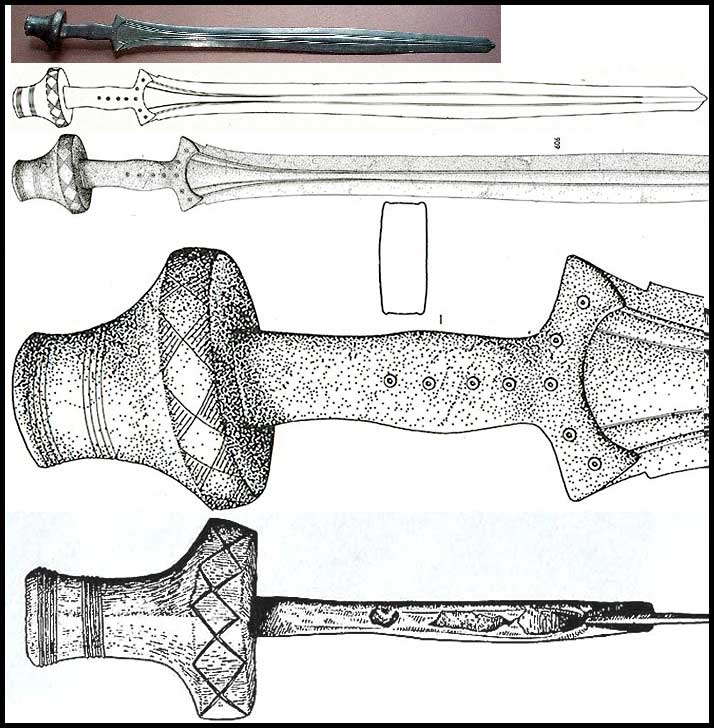 One Piece Bronze Hilt From Hallstatt Grave 607. Length 89 cm. Maximum Width 73 mm. Pommel Width 79 mm. Natural History Museum Wein. Photo Source Schauer 1971 & Cowen 1967. The Kemmathen sword also has a bronze hilt, yet it is “achieved by riveting separate side-plates of bronze to the tang, precisely as if they had been side-plates made of wood, or any other material (Cowen, 1967).” Each of these bronze side-plates have upward extensions that fit on either side of the pommel-piece into a slot in the under-side of the pommel. 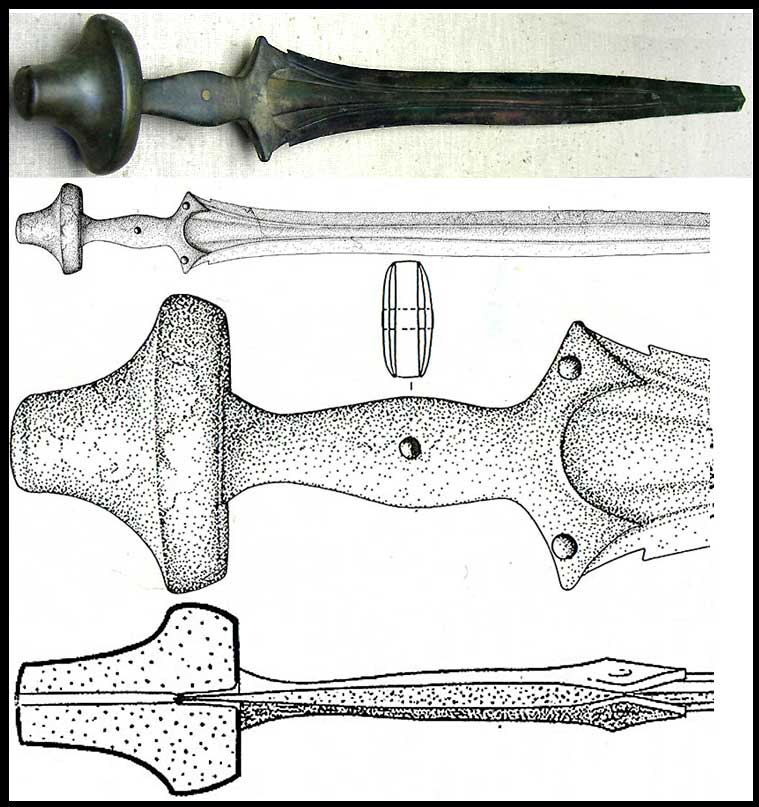 The Kemmathen Sword. Length 86 cm. Maximum Width 79 mm. Pommel Width 81 mm. Found at Kemmathen, Bayern, Germany. Prahist. Staatsslg. Munchen Germany. Photo source Schauer 1971 & Cowen 1967 (Drawings), C.L. Miller (Photo). Gundlingen As a Poorer Man’s MindelheimThe dominant sword types of the Hallstatt C period were the Gundlingen and Mindelheim. The Gundlingen was shorter, more plain and much more common. The Mindelheim was longer, more decorative and much less common. Based on catalog data of J.D. Cowen, archeologists find about ten Gundlingen swords for every one Mindelheim. It is tempting to try and see the shorter less decorative Gundlingen as an earlier more primitive form that evolved into the longer more decorative Mindelheim. Yet it is now widely believed that the two sword types are contemporary. As such, they may simply reflect geographic preferences. Cowen admits the possibility that the shorter more modest Gundlingen type could be a less decorative and cheaper version of the Mindelheim type. In this case the Gundlingen might be seen as a simpler more economical design made for the foot-soldier, but based in form upon the Mindelheim, the longer sword of the mounted tribal warlord. The Gundlingen was of moderate length so it could serve both on foot and on horseback. This would explain why most of the Gundlingen type retains it long slender point. It would allow for the thrust, which would be more effective on foot. The Differing Distribution of Mindelheim and GundlingenDistribution maps for the Mindelheim type show a large cluster near their source in southern Germany and a sprinkling northward along the amber trade routes to the Baltic and then into Denmark, Sweden and Norway. There are a few of the Gundlingen that track northward through the same regions as the Mindelheim. However, the vast majority are dispersed westward from their source in southern Germany, across France to England and then all the way to the west coast of Ireland. If it is true that the Gundlingen is, not a poor man’s, but at least a poor er man’s Mindelheim, then the sword distribution maps suggest that the “richer” went north and the “poorer” went west. Or it could be that the rich Mindelheim owners stayed in the homeland of southern Germany and traded a few of their fancy Mindelheim swords northward along the Baltic amber trade route. On the other hand, poorer warriors of the Gundlingen type moved westward along the advancing front of the Hallstatt culture. It is possible that the distribution in type is associated with trade relations rather than migrations of warriors whether rich or poor. As such we might consider the theory that , in the source area, the Hallstatt culture develops better designed swords and began to offer them as a trade items. There are two basic forms, one shorter, with a plain lenticular blade (Gundlingen) and the other longer with a central rib, decorative blade and pommel spike for pommel attachment (Mindelheim). If these two types were offered in trade then we might expect the form most similar to the indigenous Bronze Age swords of a particular area would be more widely accepted. The Bronze Age swords of Western Europe, and especially the British Isles, were generally shorter and more plain, with lenticular undecorated blades. Traded in these areas, the Gundlingen would be more similar and thus more attractive. As such the Gundlingen would find a greater market in areas west as the distribution pattern shows. Likewise the Mindelheim with its longer more decorative blades with central rib and decorative hilts would be similar to the longer ribbed blades and decorative hilts of the Nordic Bronze Age. As such they would be more likely to trade northward into the Nordic regions as the distributioin patterns show. Considering this theory to explain distribution patterns, it is interesting that one of the only bits of evidence for the shape of the Gundlingen pommel is a full-sized wooden model of a Gundlingen sword found at Cappagh in Kerry County. It is now housed in the National Museum of Ireland at Dublin. This curious find, shows a Gundlingern sword complete with side-plates and pommel and an acute ricasso-notch. The pommel is of a hat-shape like the pommels of Mindelheim swords, however, the crown is a bit lower giving a more truncated top. J.D. Cowen sees this as the first decisive evidence for the shape of the pommels of Gundlingen swords; and proves that at least some, if not most Gundlingen swords had a simplified versions of the distinctive Mindelheim hat-form (Cowen, 1967). Yet the fact that the pommel is truncated into a more mushroom shape such as was common on the Late Bronze swords of the British Isles, suggests again, that the familiar forms may have influenced their distribution through trade. The more mushroom shape of the Gundlingen, as with its shorter length and plain style would find a market in these regions. Hallstatt C and Horsemen From The EastTo understand what caused these new forms of Hallstatt swords to appear in the first place, we must first consider the larger context. The same rapid development and distribution of Hallstatt C swords can also be seen in terms of the culture as a whole. Though still Hallstatt, the transition from HaB to HaC was quite dramatic—both in terms of geographic expansion and changes in material culture. It was the beginning of chariot (cart or wagon) burials, with accompanying bit and bridal fittings showing these warriors were riding on horseback and in war chariots. It was a time when Hallstatt culture expanded northward and westward just as swords were beginning their transition to iron. Exactly what caused these changes is a mystery. A mystery made deeper by the older designation of Hallstatt as the source of all things Celtic. With this the mystery touches upon the question of Celtic origins. And like the beauty of Celtic art, it is a beguiling question and carries us further into a realm of speculation. One of the most widely considered theories for the Hallstatt C explosion of culture and trade revolves around the movement of “pre-Scythian horseman.” For instance the displacement of the Thraco-Cimmerians warriors by the Scythians from the steppes to the east. These horsemen raided deep into the Upper Danube River Valley coming into contact with the Hallstatt settlements. How did these horsemen cultures influence the Hallstatt culture? If it was simply cultural diffusion of technologies and design, then the contact would not involve a displacement of population. Rather the military engagements or trade relations would introduce the Hallstatt culture to stronger breeds of horses, loose trousers for ease of riding horseback, chariot or wagon technology, maybe even steely iron used in the rims of the wagon wheels. Cultural diffusion would take place as the Hallstatt people would gradually develop social stratification into an indigenous aristocratic ruling class typical of Scythian cultures, possibly as a necessity to organize defense against the horsemen raids—fighting fire with fire, or rather horses with horses. In this case borrowed fire from whom they were fighting. Over time, this thoroughly Hallstatt warrior class might also adopt similar burial customs. On the other hand, if this change occurred as cultural migration of population, then the ruling class of the pre-Scythian horseman, of possible Iranian background, may have established themselves as a new dynasty or ruling class over indigenous Urnfield/Hallstatt populations, bringing their horseman culture, as well as their attitudes of trade and expansion, wholesale into the Hallstatt culture. In modern terms, Hallstatt Inc. would be under new management, with a thoroughly eastern long-range vision for growth and development. Social Stratification and Late Hallstatt BurialsIn either case, diffusion or migration, the rapid changes in burial customs between HaB and HaC indicates that the culture underwent a dramatic social stratification. In HaC, Hallstatt cemeteries begin to show a variety of graves. There are a very few rich inhumation graves walled with planks, containing wooden vehicles, horses and many rich grave goods all under an impressive mound or tumulus. Along side these are many more modest warrior graves each with his long sword of bronze or iron along with harness fittings for their mounts. There were other graves with no weapons, but an array of bronze and pottery vessels. There were also many graves with nothing more than a joint of pork and a knife for the dead man’s spirit to eat it. A perennial conclusion of this assortment of burials is that it clearly shows a lower working class dominated by a higher warrior class that was itself controlled by powerful chieftains. Hallstatt Swords Change Then DissappearIn terms of the sword, it would be interesting to compare the swords of the Pre-Scythian horsemen with those of the Hallstatt C to see if there are any similarities. The problem is that there are very few records of these early horsemen having swords of any kind. And of the few references to grave finds of Scythian swords, I have had no luck in securing pictures of these swords. Oblique descriptions imply that they were rather short, possibly litter more than overgrown daggers. Since we are deep in the realm of speculation, let me carry it one step further. If we agree that the horsemen from the east really did impact the latter part of the Hallstatt period and we assume that the first encounter was one of cultural diffusion during the time of the Cimmerians. And if we assume that this was followed three generations later by a cultural migration of Scythians warriors, the ones who chased the Cimmerians into the area in the first place—if we assume these things, then we could explain, at least in outline, the development and disappearance of the Hallstatt sword throughout this period. The speculation would go something like this: As the Cimmerians made contact either in trade or war, the Hallstatt culture learned from them and began to adopt their mounted fighting style. However, the sword was the primary weapon of the Hallstatt warrior (spears are much more rare than swords in Hallstatt graves). As such, it is only natural that mounted Hallstatt warriors would want to use their bronze swords in battle. The development of the Hallstatt C swords would follow this new function and the first Cavalry swords in Europe would appear. The sudden appearance of this new fighting force would give them political leverage they would use to select chieftains who would mirror those of the Steppes. A new social stratification would develop around these chieftains, who would use their power and prestige to extent the Hallstatt culture westward and northward in trade and growth. At the beginning of HaD, the Scythian Horsemen would have made their way far enough to the west to influence the Hallstatt culture, not by diffusion, but this time by way of cultural migration as their ruling elite of Iranian background, would do what they had been doing for centuries—They would replace the indigenous Hallstatt chieftains as a new foreign dynasty. With this the new management would train the warriors to use the the primary weapon of the Scythian, the bow. The sword would disappear and The dagger would be retained as the sidearm for close combat. Eventually the dagger would become the prestige weapon the sword once was. Pure speculation—but it explains the rapid fluctuation in sword design in the late Hallstatt from a relatively sudden development and dispersion of Europe’s first Cavalry weapon and then its equally rapid disappearance to be replaced with the dagger. In this context, it would be interesting to compare the daggers of HaD with the Scythian horseman cultures.Hallstatt C Swords as a Cavalry WeaponsWhat is the evidence that the Hallstatt C swords were designed for use on horseback or chariot? Blade FormFor the Hallstatt C swords advanced the emphasis on slashing which had begun to develop at the end of the Late Bronze Age. They were designed for “power to deliver the slashing blow (heavy blades, thick necks), with no attempt to preserve the power of thrusting (blunt, triangular points)” (Cowen, 1967). It is clear that these swords were not used for thrusting, and this is “emphasized in many cases by the point not being a point at all, for it is either of a rounded spatulate form, or cut off practically square, or drawn out into a sort of fish-tail (Oakeshott, 1960).” This will be as good a place as any to give a brief explanation why the thrust is not usually associated with mounted combat and why a thrusting point might be removed all together. Image you are on horseback in the midst of a battle. If you were to thrust your sword into someone as you were riding by you must carry them along on the end of your sword. Most mortal men do not have that kind of arm strength. So you either let go of your sword or you stop your horse. Its only in Hollywood that foot-soldiers have sword fights with mounted warriors as their horses prance around in one place. As we see in Scythian art, and as we should know from common sense, if the horse stops the foot-soldier stabs the horse, quickly making the mounted warrior a foot-soldier. As such horsemen, if they want to remain horsemen, must move during an engagement. So the thrust is out of the question. Broad sweeping cuts are the order of the day. It may be that the pointed tips of Mindelheim, and later long La Tene cavalry swords, were blunted so that the mounted swordsman was not tempted to stop and poke at their opponents. In some cases, if you look closely the tips even flare a bit into a slight re-curve called a “fish-tail.” Now that would make a scary cut traveling with the slashing force of strong arm and the forward momentum of a thousand pounds of horseflesh. LengthOnly two of the known Mindelheim swords are less than 80 centimeters (approx. 32 inches). The longest measures almost 94 centimeters (approx. 38 inches). This is a dramatic increase in length compared to earlier bronze swords. It is believed that the greater length would better enable warriors to reach their foes when fighting from chariots, or from horseback. The Gundlingen swords also show a significant increase in length, especially in Southern Germany and France where the most common length is between 70 and 75 centimeters (28-30 inches). In the British Isles they are generally under 70 centimeters (28 inches) and in Ireland they are even shorter (Cowen, 1967). Securing the PommelIt is clear that securely fixing the pommel directly to the tang was a new and continual concern of the swordsmiths of the Hallstatt C period. Cowen suggests that this obvious fussiness implies the shape and size of the Hallstatt’s hat-shaped pommels were in some way more unmanageable than the earlier ovoid knobs or antennas seen on the flanged hilts of the Late Bronze Age. Thus they required different devices of attachment (Cowen, 1967). This concern with pommel attachment could also be a result of the greater angular momentum and shock produced by longer and heavier swords dislodging and loosening pommels not attached directly to the tang. This becomes even clearer when we consider the distribution of stress on hilt components during a thrust as opposed to a cut. In a thrust, the forward momentum of the hand slides forward placing most of the stress on the shoulders of the blade. However, in a cut, the angular momentum slides the hand back, placing stress on the pommel. And in a shorter cut by bending at the wrist, the heel of the hand leverages one side of the broad pommels. As such the problem of the loose pommel may be simply a result of more cutting and less thrusting—something that is also suggested by the changing blade form, especially the blunted triangular tips. Yet another possibility is that the sword was being handled or jostled in such a way as to cause the pommel to work itself loose. If we were to conclude that the type of continuous up and down motion of a sword carried on horseback might more easily work the pommel loose, then the defining feature of the pommel-piece to secure the pommel directly to the tang might very well be the result of building a sword to be used from horseback. ChapesNot only the sword, but the scabbard fittings can also suggest a design for use from horseback. When drawing a sword from the scabbard, especially with a baldric, it is usual to grab the scabbard with one hand and pull the sword with the other. However on horseback, one hand is occupied with holding the reins. So the problem arises of how to draw the sword from the scabbard with only one free hand. As Prof. J.L. Myres recognized, the device of the large winged chapes (metal cap at the tip of the scabbard) on Hallstatt scabbards may have been the solution to this problem. For the winged shape of the chape would allow one hand to hold the reins as the wings of the chape were hooked behind the thigh or under the arm or foot to anchor the scabbard and facilitate the drawing of the sword with the other free hand. If it is true that this feature functioned to allow the sword to be drawn with one hand, it supports the view that the longer Hallstatt swords were used as cavalry weapons. These winged chapes again indicate cultural diffusion from the east. For similar winged chapes can be seen carved on Assyrian wall panels from Khorsabad. 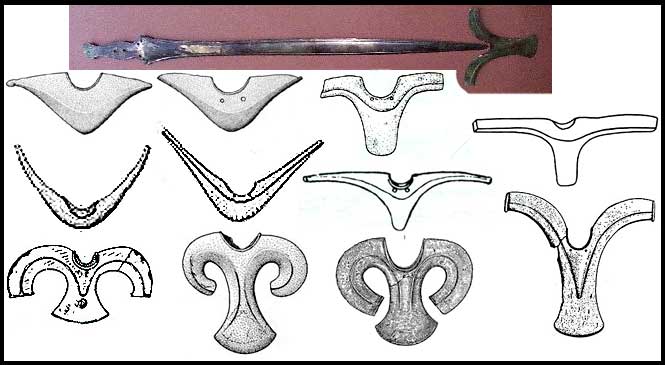 Various Winged Chapes of Hallstatt Sword Scabbards. Photo compiled from the TOMBA project. Recurved Winged Chapes—Detail of Assyrian Panel from Khorsabad. Inset of a Hallstatt winged chape from Frankfurt, Germany. Before we leave this discussion of why the Mindelheim may be the first cavalry sword in Europe, we should consider its impact on the future. As the Mindelheim continues the move toward a slashing sword with strong pommel attachments it is very likely the source of what would eventually lead to the cruciform cavalry swords of the high middle ages. It would inspire the long swords of the La Tene culture, that influenced the form of Roman spathas, which in turn, find reflection in the shape of Germanic spathas that developed into Viking and Saxon swords, which would in time become the classic medieval sword.From Bronze to IronThe Hallstatt culture of the Bronze Age first appears in the iron-rich regions of southern Germany. So it is appropriate that this culture would become a bridge of continuity between the age of bronze and iron. It it in the HaC swords of Mindelheim and Gundlingen types that we see the same type of sword, existing side by side, in both iron and bronze. In some cases, iron and bronze components were found on the same sword as in Beilngries, Bavaria where iron swords were found with bronze pommels (Cowen 1967). The shorter Gundlingen swords were most usually of iron and the longer Mindelheim were more evenly distributed between bronze and iron (Cowen, 1967). Iron Age MisconceptionsIt is commonly thought that iron was not in use before the Iron Age. It is even more commonly believed that iron is harder than bronze. Neither is true. Iron tools have been found at least 2000 years before the European Iron Age began and iron did not even reach the harness of work-hardened (hammered) bronze until the discovery of alloying iron with small amounts of carbon (carburization) to make steely iron. More over, iron was not significantly harder than work-hardened bronze until quench hardening was discovered (Waldbaum, 1978).The Earliest IronThe earliest iron find with a clear context is a small iron dagger, dated at about 2500 B.C., found in a burial at the Early Iron Age town of Alaça Hüyük in central Turkey. Dagger with iron blade and gold plated wooden hilt. Found Alaça Hüyük, central Turkey c. 2500 B.C. Image from “The European Iron Age” by John Collis, 1984 Iron has also been found at Troy in association with gold and a valuable blue stone known as lapis lazuli. This association illustrates something archeologist already knew from textual evidence: until the Iron Age, iron was a prestige material. In other words, it was rare and very expensive. An Assyrian text from a colony of Assyrian merchants near Hattusas Turkey, places the value of iron at five times that of gold. Other Assyrian documents suggest it was closer to 8 times the value of gold. That means you would have to trade at least five gold daggers to get one of iron. That also means if you ever go back in time, at least before the Iron Age, don’t take gold—Take a bunch of scrap iron! In the 14 th century, King Tutankhamen was buried with two daggers, one of iron and one of gold. While today we would see the gold dagger as the most valuable, at the time of King Tut’s burial, it was the iron dagger that showed his opulent wealth. The gold dagger was somewhat quaint. The precious iron of Tut’s dagger supports the known historical connection of the Egyptian and Hittite royal houses at this particular juncture in history. For it is commonly believed that the Hittites were the first be smelt and forge iron. The association of iron and gold may be a clue to how the first iron was smelted. When gold is mined it often occurs with magnetite sands. Magnetite is dense and would be collected with the gold. And as its name suggest, Magnetite is an iron ore. It may be, while smelting gold iron was discovered by accident (Forbes, 1964).Iron Age DelayIf iron working existed during the entire Bronze Age; and if iron, in its mineral form (Hematite), rock form or bog iron, is much more common and widely distributed than copper; and if iron’s hardness depends on the extremely common alloy of carbon whereas copper, to be bronze, must be alloyed with tin, which is quite rare—if all of these things are true, then why did it take so long for the Iron Age to begin? Here are some possible reasons:Completely New TechnologyUltimately the question of the delay of the Iron Age, or the delay of anything, is an issue of time. And the ancients had a completely different conception of time than modern man. The modern world looks forward to continued improvement. The ancient world looked back to an earlier golden age. Or in more simple terms, to the modern mind, new is good (state of the art) and old is bad (out of date and old-fashion). Yet to the ancients old was good (tested and proven) and new was bad (unproven and chancy). If we accept this difference, then change in the ancient world would take place at a slower rate, especially a change that involved a whole new set of skills (forging to shape) and could not be related to a current proven technology (casting in molds). Learning Curve of The ForgeThe reason working iron would require a new set of skills is simply due to the fact that iron has a very high melting point. Bronze, gold, silver, copper or lead could be melted. The impurities could be easily and efficiently removed in the molten state. And, as liquid, these molten metals could be poured into molds. On the other hand, until modern times, there simply were not ovens that could generate the heat needed to melt iron. Thus casting iron tools and weapons in molds was not an option to the ancients. To remove the impurities and to work the iron into the desired shape, a new set of skills would be required. Not that it was necessarily that much more difficult, just different—and quite mysterious. Early iron-smiths probably considered it some form of magic or work of a god, such as Vulcan. The forge would remain mysterious throughout history. R.J. Forbes, in his book “Man the Maker: A History of Technology and Engineering,” says that up until the 18 th century A.D., smiths had no idea that to make quality steel from iron involved carbon addition. They thought they were removing some kind of impurity. The charcoal was not adding anything to the iron rather it was somehow scrubbing something away. Quality Control Problems As mentioned earlier, the iron of the Early Iron Age was not superior to the bronze of the Late Bronze Age. To even approach the harness of work hardened (hammered) bronze the iron must be alloyed with very small amounts of carbon, and the alloy must be of the right percentages. Throughout much of the Early Iron Age this was a trial and error, hit and miss, proposition. It sometimes resulted in good quality steely iron but the makers were probably unaware of exactly how it was done. They did not know it was Sulphur that made the iron brittle or Phosphorus that allowed it to be work hardened by hammering like bronze. So there was a “quality control” issue early on. Actually it existed throughout the middle ages also. Much of the history of the metallurgy of the Iron Age is trying to deal with this quality control issue. One of the techniques used to increase the quality was a process of combing layer or wires of iron with a carburized hardened surface—a process termed piling. Later the rods or wires were twisted producing the patterns of pattern-welding. In this way the softer iron and the harder carbon steel would be mixed like twisted taffy, producing an overall higher carbon content and thus a more steely iron. It was not until quenching was discovered that the hardness of steely iron was significantly superior to hammered bronze. So, if iron is not significantly superior to bronze, there would be very little incentive to use it for tools or weapons. There must be some other factor that forced iron to center stage as a viable alternative to bronze. Early MonopolyBecause of the mysterious “trade secret” nature of the early iron forge technology, and considering iron’s extreme value as a prestige material, it is very likely that a monopoly developed, at least in part, around iron smelting and forging secrets. “As for the good iron which you wrote about to me, good iron is not available in my seal-house at Kizzuwatna. That it is a bad time for producing iron, I have written. They will produce good iron, but as yet they will not have finished. When they have finished, I shall send it to you. Today now I am dispatching an iron dagger-blade to you…” Letter from Hittite King Hattusilis III (1275-1255)Found at Hattasus Turkey. To an unnamed king. (Recorded in “The European Iron Age” by John Collis) This letters indicates there was some form of oversight or control of iron production by the Hittite kings. The letter also suggests that, while still valuable as a prestige item, iron was becoming refined for more utilitarian purposes such as personal weapons. The fact that it is variable in quality may imply they were beginning to discover carburization. It should also be brought up in this context that as soon as the Hittite Kingdom collapsed in the late 13 th century, we see iron technology begin to appear in wider geographical distribution (Forbes, 1964). It is also at this time that iron begins in earnest to make the transition from a precious metal of the prestige class to a more weapons-grade material. The Iron Age ArrivesSo what was it that finally allowed the Iron Age to begin in earnest? European climate studies indicate that the climate in northern Europe went through rapid changes around 1300 B.C.—First warmer and dryer and then colder and wetter. This may have set into motion a domino effect of migrations; the most devastating being the eastward movement of the Sea People. As the Sea People migrated from west to east around the eastern Mediterranean coast they destroyed important urban centers. Just as it is thought that the fall of Constantinople in 1453 A.D. allowed lost texts of Aristotle to prepare the way for a Renaissance into the modern world, so the fall of the Hittite Kingdom to the Sea People in 1200 B.C. may very well have allowed the trade secrets of iron to escape into the Mediterranean world preparing the way, eventually, for another Renaissance, of sorts, into the classical world. As the Iron Age began, we see iron technology taking hold in other areas—in Cyprus, then Greece and also the Levant coast, possibly an offshoot of the Sea People known as the Philistines carried it there as a technology stolen from the Hittites. The crisis of the 12 th century, not only dispersed the trade secrets of iron, it also led to the closing of mining and trading centers. Soon it was difficult for bronze workers to find sources for copper and tin to make bronze. There is clear archeological evidence of an increase in hording and reuse of bronze following the crisis of the 12 th century. The new availability of iron technology coupled with the lack of availability of bronze may have been the most important catalyst to open up the Iron Age. In other words, the Iron Age may have been given its chance, not because iron was better, but bronze was scarce. The Hallstatt Swords In IronIt is difficult to see the decorative detail and even the overall form of many of the early iron Hallstatt swords simply because they are severely corroded. However there are a few which have much of the original surface preserved. Most of these do not have blades with the same decorative detail of their bronze predecessors. This would be expected. For with bronze casting the work of carving decoration into a stone mold would have to be done only once for the many swords cast in that mold. Yet with a forged blade, each must be decorated individually. Such beautiful detail on iron swords would have to be cut or chiseled into the surface of each and every piece. There are a few iron Hallstatt swords, which have been chiseled and polished in such a fashion, and they are equal in beauty with the best of the cast bronze blades. It has been suggested that the really decorative Mindelheim swords, with their fine and fragile ivory pommels, were ceremonial parade swords and were not made for battle. As such, it could be proposed that the earliest iron swords might also be only for show, since it is likely that iron still maintained its status as a prestige material. However, this is not very likely. For ivory is not fragile. It was a common material used on sword hilts during the Roman period. Also Cowen indicates that iron was more common in the Gundlingen type than the more fancy Mindelheim. Also consider that these “parade” swords had hardened and sharpened edges and the pommel was secured with hooks, rivets and pommel spikes, which would suggest they were made to take the abuse of battle. The Pommel Spike, Past and FutureThe last device developed to stabilize the pommel was a rod-like extension from the pommel-piece called a pommel spike. In some cases it did not pass all the way through the pommel, in most it did. Where the pommel spike passes all the way through the pommel, it ends with a button tab to secure the pommel by clinching it to the tang with pressure. It is essentially the same principle found in the earlier Nordic Bronze Age rod hilt swords, what German spathologists call griffangelschwerter (Grip Fishing Rod Sword). It is also found on earlier Hittite swords. And later this principle would be used by the swordsmiths of the LaTene culture. As a matter of fact, it is this very principle of through the grip pommel attachment that would finally solve the loose pommel problem and would be found on swords throughout the rest of history. Through- the-Grip rod-like tangs occur before and after Hallstatt. The Pommel spike seems to be part of this trend. Photo source Schauer 1971, the TOMBA project and Polemos I & II: Le Contexte Guerrier en Egee A L’Age Du Bronze” Robert Laffineur ed.ConclusionThe Mindelheim sword reflects a time of transition and trade; and a place that existed between two worlds. Its handsome form and decoration is the product of a middle-earth between the age of bronze and the coming age of iron. To its north we find the beautiful bronze work of the Nordic Bronze Age and the Urnfields, to the south the coming of iron and the classical world. And in between, and in transition, the Mindelheim sword catches, in its decoration and design, the earlier geometric forms of Nordic and Urnfield. Yet the structural devices of its hilt points forward to the future—a sword adapted to horse warfare, securing the pommel as not only counter weight, but as a firm base for broad cutting strokes. And an accompanying blade design to make these strokes felt. In less than a century, the older geometric forms that decorate the Hallstatt swords would be replaced with the whimsical flowing curves of the floral and animal patterns of the La Tene Culture—and with this new aesthetic something would happen in central Europe, in the western shadow of Hallstatt, that would ignite an explosion of Celtic art that is still being felt to this day. Kirk SpencerDallas, TexasDecember 1, 2006 BioLive in Dallas, Texas with my wife Terri and our 5 children.Professor of Science and History at The Criswell College.Have taught college level courses in the fields of science and history for the last 23 years.Have studied the sword in all its history since 2000.Currently working on a photo archive data-base for swords, sabers and dirks. CITATIONS Collis, John. “The European Iron Age,” 1984. Cowen, J.D., “The Hallstatt Sword of Bronze: on the Continent and in Britain,”Proceedings of the Prehistoric Society, Volume 33, 1967 Forbes, R.J., “Man the Maker: A History of Technology and Engineering,” 1958. Forbes, R.J., “Studies in Ancient Technology,” 1964 Oakeshott, R. Ewart, “The Archaeology of Weapons: Arms and Armour from Prehistoryto the Age of Chivalry,” 1960. Schauer, Peter. “Die Schwerter in Suddeutschland, Osterreich und der Schweiz I”Prahistorische Bronzefunde Abteilung IV. Band 2. 1971. Waldbaum, Jane C, “From Bronze to Iron: The Transition from the Bronze Age to theIron Age in the Eastern Mediterranean,” 1978. |